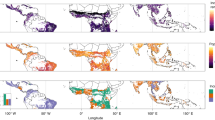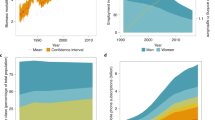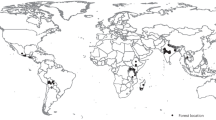Abstract
Community forest management (CFM) has been promoted for decades as a way to merge environmental conservation with economic development and natural resource rights agendas. Yet many of these initiatives have also led to substantial socioeconomic and environmental trade-offs. We present a comprehensive global analysis of environmental, income and natural resource rights outcomes of CFM, using data from 643 cases in 51 countries. We find that while the majority of cases reported positive environmental and income-related outcomes, forest access and resource rights were often negatively affected by policies to formalize CFM, countering one of CFM’s principal goals. Positive outcomes across all three dimensions were rare. We show that biophysical conditions, de facto tenure rights, national context, user-group characteristics and intervention types are key predictors of joint positive outcomes. These findings highlight key conducive conditions for CFM interventions, which can inform CFM design to ensure positive outcomes across multiple sustainability dimensions.
This is a preview of subscription content, access via your institution
Access options
Access Nature and 54 other Nature Portfolio journals
Get Nature+, our best-value online-access subscription
$29.99 / 30 days
cancel any time
Subscribe to this journal
Receive 12 digital issues and online access to articles
$119.00 per year
only $9.92 per issue
Buy this article
- Purchase on Springer Link
- Instant access to full article PDF
Prices may be subject to local taxes which are calculated during checkout



Similar content being viewed by others
Data availability
The data used for this analysis is available at: http://www.forestlivelihoods.org/resources/.
Code availability
All computer code used in this analysis is available from the authors upon reasonable request.
References
Houghton, R. A., Byers, B. & Nassikas, A. A. A role for tropical forests in stabilizing atmospheric CO2. Nat. Clim. Change 5, 1022–1023 (2015).
Newton, P., Oldekop, J. A., Brodnig, G., Karna, B. K. & Agrawal, A. Carbon, biodiversity, and livelihoods in forest commons: synergies, trade-offs, and implications for REDD+. Environ. Res. Lett. 11, 044017 (2016).
Angelsen, A. et al. Environmental income and rural livelihoods: a global-comparative analysis. World Dev. 64, S12–S28 (2014).
Lund, J. F., Rutt, R. L. & Ribot, J. Trends in research on forestry decentralization policies. Curr. Opin. Environ. Sustain. 32, 17–22 (2018).
At a Crossroads: Consequential Trends in Recognition of Community-Based Forest Tenure (Rights and Resources Initiative, 2018).
Ribot, J. C., Agrawal, A. & Larson, A. M. Recentralizing while decentralizing: how national governments reappropriate forest resources. World Dev. 34, 1864–1886 (2006).
Charnley, S. & Poe, M. R. Community forestry in theory and practice: where are we now? Annu. Rev. Anthropol. 36, 301–337 (2007).
Cronkleton, P., Pulhin, J. M. & Saigal, S. Co-management in community forestry: how the partial devolution of management rights creates challenges for forest communities. Conserv. Soc. 10, 91–102 (2012).
Gilmour, D. Forty Years of Community-Based Forestry: A Review of Its Extent and Effectiveness (FAO, 2016).
Baynes, J., Herbohn, J., Smith, C., Fisher, R. & Bray, D. Key factors which influence the success of community forestry in developing countries. Glob. Environ. Change 35, 226–238 (2015).
Chhatre, A. & Agrawal, A. Trade-offs and synergies between carbon storage and livelihood benefits from forest commons. Proc. Natl Acad. Sci. USA 106, 17667–17670 (2009).
Persha, L., Agrawal, A. & Chhatre, A. Social and ecological synergy: local rulemaking, forest livelihoods, and biodiversity conservation. Science 331, 1606–1608 (2011).
Rasolofoson, R. A. et al. Impacts of community forest management on human economic well-being across Madagascar. Conserv. Lett. 10, 346–353 (2017).
Oldekop, J. A., Sims, K. R. E., Karna, B. K., Whittingham, M. J. & Agrawal, A. Reductions in deforestation and poverty from decentralized forest management in Nepal. Nat. Sustain. 2, 421–428 (2019).
Agrawal, A. & Benson, C. S. Common property theory and resource governance institutions: strengthening explanations of multiple outcomes. Environ. Conserv. 38, 199–210 (2011).
Larson, A., Barry, D. & Dahal, G. R. New rights for forest-based communities? Understanding processes of forest tenure reform. Int. For. Rev. 12, 78–96 (2010).
Hajjar, R., Kozak, R. A. & Innes, J. L. Is decentralization leading to ‘real’ decision-making power for forest-dependent communities? Case studies from Mexico and Brazil. Ecol. Soc. 17, 12 (2012).
Newton, P. et al. What Are the Biophysical, Institutional, and Socioeconomic Contextual Factors Associated with Improvements in Livelihood and Environmental Outcomes in Forests Managed by Communities? A Systematic Review Protocol Working Paper 9 (CIFOR, 2015); https://doi.org/10.17528/cifor/005494
Hajjar, R. et al. The data not collected on community forestry. Conserv. Biol. 30, 1357–1362 (2016).
Vyamana, V. Participatory forest management in the Eastern Arc Mountains of Tanzania: who benefits? Int. For. Rev. 11, 239–253 (2009).
Mohammed, A. J. & Inoue, M. Forest-dependent communities’ livelihood in decentralized forest governance policy epoch: case study from West Shoa zone, Ethiopia. J. Nat. Resour. Policy Res. 5, 49–66 (2013).
Nielsen, M. Improving the conservation status of the Udzungwa Mountains, Tanzania? The effect of joint forest management on bushmeat hunting in the Kilombero Nature Reserve. Conserv. Soc. 9, 106–118 (2011).
Gobeze, T., Bekele, M., Lemenih, M. & Kassa, H. Participatory forest management and its impacts on livelihoods and forest status: the case of Bonga Forest in Ethiopia. Int. For. Rev. 11, 346–358 (2009).
Mishra, T., Mandal, D. & Maiti, S. Evaluation of regeneration of Shorea robusta forests under joint forest management in West Bengal, India. Int. J. Environ. Sustain. Dev. 5, 12–22 (2006).
Oyono, P., Samba, S. & Biyong, M. Beyond the decade of policy and community euphoria: the state of livelihoods under new local rights to forest in rural Cameroon. Conserv. Soc. 10, 173–181 (2012).
Oldekop, J. A., Holmes, G., Harris, W. E. & Evans, K. L. A global assessment of the social and conservation outcomes of protected areas. Conserv. Biol. 30, 133–141 (2016).
White, I., Royston, P. & Wood, A. Multiple imputation by chained equations: issues and guidance for practice. Stat. Med. 30, 377–399 (2011).
Leuschner, C., Moser, G., Bertsch, C., Röderstein, M. & Hertel, D. Large altitudinal increase in tree root/shoot ratio in tropical mountain forests of Ecuador. Basic Appl. Ecol. 8, 219–230 (2007).
Thanichanon, P., Schmidt-Vogt, D., Messerli, P., Heinimann, A. & Epprecht, M. Secondary forests and local livelihoods along a gradient of accessibility: a case study in northern Laos. Soc. Nat. Resour. 26, 1283–1299 (2013).
Schlager, E. & Ostrom, E. Property-rights regimes and natural resources: a conceptual analysis. Land Econ. 68, 249–262 (1992).
Place, F. & Hazell, P. Productivity effects of Indigenous land tenure systems in sub-Saharan Africa. Am. J. Agric. Econ. 75, 10–19 (1993).
Gibson, C., Lehoucq, F. & Williams, J. Does privatization protect natural resources? Property rights and forests in Guatemala. Soc. Sci. Q. 83, 206–225 (2002).
Bugri, J. T. The dynamics of tenure security, agricultural production and environmental degradation in Africa: evidence from stakeholders in north-east Ghana. Land Use Policy 25, 271–285 (2008).
Cronkleton, P. & Larson, A. Formalization and collective appropriation of space on forest frontiers: comparing communal and individual property systems in the Peruvian and Ecuadoran Amazon. Soc. Nat. Resour. 28, 496–512 (2015).
Nayak, P. K. & Berkes, F. Politics of co-optation: community forest management versus joint forest management in Orissa, India. Environ. Manage. 41, 707–718 (2008).
Berkes, F., George, P. & Preston, R. J. Co-management: the evolution in theory and practice of the joint administration of living resources. Alternatives 18, 12–18 (1991).
Humphries, S., Holmes, T., de Andrade, D. F. C., McGrath, D. & Dantas, J. B. Searching for win–win forest outcomes: learning-by-doing, financial viability, and income growth for a community-based forest management cooperative in the Brazilian Amazon. World Dev. https://doi.org/10.1016/j.worlddev.2018.06.005 (2018).
Bray, D. B. et al. Mexico’s community-managed forests as a global model for sustainable landscapes. Conserv. Biol. 17, 672–677 (2003).
Balooni, K., Pulhin, J. & Inoue, M. When is Decentralization in Forest Management a Success and when is it a Failure? Case Studies from the Philippines (Indiana Univ., 2007).
Oldekop, J. A., Bebbington, A. J., Brockington, D. & Preziosi, R. F. Understanding the lessons and limitations of conservation and development. Conserv. Biol. 24, 461–469 (2010).
Rudel, T. K. et al. Forest transitions: towards a global understanding of land use change. Glob. Environ. Change 15, 23–31 (2005).
Erbaugh, J. T. & Oldekop, J. A. Forest landscape restoration for livelihoods and well-being. Curr. Opin. Environ. Sustain. 32, 76–83 (2018).
Honey-Rosés, J., Maurer, M., Ramírez, M. I. & Corbera, E. Quantifying active and passive restoration in Central Mexico from 1986–2012: assessing the evidence of a forest transition. Restor. Ecol. 26, 1180–1189 (2018).
Oldekop, J. A., Sims, K. R. E., Whittingham, M. J. & Agrawal, A. An upside to globalization: international outmigration drives reforestation in Nepal. Glob. Environ. Change 52, 66–74 (2018).
Peluso, N. L. & Purwanto, A. B. The remittance forest: turning mobile labor into agrarian capital. Singap. J. Trop. Geogr. 39, 6–36 (2018).
Sikor, T. & Nguyen, T. Q. Why may forest devolution not benefit the rural poor? Forest entitlements in Vietnam’s central highlands. World Dev. 35, 2010–2025 (2007).
Pulhin, J. M. & Dressler, W. H. People, power and timber: the politics of community-based forest management. J. Environ. Manage. 91, 206–214 (2009).
Jones, J. P. G. et al. Human migration to the forest frontier: implications for land use change and conservation management. Geo 5, e00050 (2018).
Robson, J. P. & Berkes, F. Exploring some of the myths of land use change: can rural to urban migration drive declines in biodiversity? Glob. Environ. Change 21, 844–854 (2011).
Brooks, J. S., Waylen, K. A. & Borgerhoff Mulder, M. How national context, project design, and local community characteristics influence success in community-based conservation projects. Proc. Natl Acad. Sci. USA 109, 21265–21270 (2012).
Larson, A. M. & Soto, F. Decentralization of natural resource governance regimes. Annu. Rev. Environ. Resour. 33, 213–239 (2008).
Anderson, J., Mehta, S., Epelu, E. & Cohen, B. Managing leftovers: does community forestry increase secure and equitable access to valuable resources for the rural poor? For. Policy Econ. 58, 47–55 (2015).
Thanh, T. N. & Sikor, T. From legal acts to actual powers: devolution and property rights in the Central Highlands of Vietnam. For. Policy Econ. 8, 397–408 (2006).
Larson, A. M., Cronkleton, P., Barry, D. & Pacheco, P. Tenure Rights and Beyond: Community Access to Forest Resources in Latin America (CIFOR, 2008).
Scheba, A. & Mustalahti, I. Rethinking ‘expert’ knowledge in community forest management in Tanzania. For. Policy Econ. 60, 7–18 (2015).
Ameha, A., Nielsen, O. J. & Larsen, H. O. Impacts of access and benefit sharing on livelihoods and forest: case of participatory forest management in Ethiopia. Ecol. Econ. 97, 162–171 (2014).
Lescuyer, G. Sustainable forest management at the local scale: a comparative analysis of community forests and domestic forests in Cameroon. Small-scale For. 12, 51–66 (2013).
Guiang, E. S. & Castillo, G. Trends in forest ownership, forest resoures tenure and institutional arrangements in the Philippines: Are they contributing to better forest management and poverty reduction? (FAO, 2007).
Blackman, A., Corral, L., Lima, E. S. & Asner, G. P. Titling Indigenous communities protects forests in the Peruvian Amazon. Proc. Natl Acad. Sci. USA 114, 4123–4128 (2017).
Sikor, T. et al. Community Forestry in Asia and the Pacific: Pathway to Inclusive Development (RECOFTC - The Center for People and Forests, 2013).
Wren-Lewis, L., Becerra-Valbuena, L. & Houngbedji, K. Formalizing land rights can reduce forest loss: experimental evidence from Benin. Sci. Adv. 6, eabb6914 (2020).
Ostrom, E. Governing the Commons: The Evolution of Institutions for Collective Action (Cambridge Univ. Press, 1990).
Varughese, G. & Ostrom, E. The contested role of heterogeneity in collective action: some evidence from community forestry in Nepal. World Dev. 29, 747–765 (2001).
Lambin, E. F. & Meyfroidt, P. Global land use change, economic globalization, and the looming land scarcity. Proc. Natl Acad. Sci. USA 108, 3465–3472 (2011).
Scherr, S. J., White, A. & Kaimowitz, D. Making markets work for forest communities. Int. For. Rev. 5, 67–73 (2003).
Agrawal, A. Forests, governance, and sustainability: common property theory and its contributions. Int. J. Commons 1, 111–136 (2007).
Pagdee, A., Kim, Y. & Daugherty, P. J. What makes community forest management successful: a meta-study from community forests throughout the world. Soc. Nat. Resour. 19, 33–52 (2006).
Hajjar, R. & Oldekop, J. A. Research frontiers in community forest management. Curr. Opin. Environ. Sustain. 32, 119–125 (2018).
Methods (IFRI, 2013); http://ifri.forgov.org/resources/methods/
Persha, L., Fischer, H., Chhatre, A., Agrawal, A. & Benson, C. Biodiversity conservation and livelihoods in human-dominated landscapes: forest commons in South Asia. Biol. Conserv. 143, 2918–2925 (2010).
Geist, H. J. & Lambin, E. F. Proximate causes and underlying driving forces of tropical deforestation. BioScience 52, 143–150 (2002).
Rana, E., Thwaites, R. & Luck, G. Trade-offs and synergies between carbon, forest diversity and forest products in Nepal community forests. Environ. Conserv. 44, 5–13 (2017).
Liaw, A. & Wiener, M. R Package ‘randomForest’ (The Comprehensive R Archive Network, 2018).
Breiman, L. Random forests. Mach. Learn. 45, 5–32 (2001).
Genuer, R., Poggi, J. & Tuleau-Malot, C. Variable selection using random forests. Pattern Recognit. Lett. 31, 2225–2236 (2010).
Harrell, F. Regression Modelling Strategies (Springer, 2015).
Acknowledgements
We thank the Evidence Based Forestry Initiative at the Centre for International Forestry Research (CIFOR) and the UK Department for International Development (DfID) for financing this research through its KNOWFOR programme grant. J.A.O. was supported through an EU FP7 Marie Curie Fellowship (FORCONEPAL). P.C. was supported through the CGIAR Research Program on Forest, Trees and Agroforestry (FTA), led by CIFOR. We also thank M. Vikas, M. Burbidge, A. Langeland and K. Gregory for their help in screening papers and extracting data and G. Steward, M. Grainger, M. Whittingham, R. Preziosi and E. W. Harris for their help with the statistical analysis.
Author information
Authors and Affiliations
Contributions
R.H., J.A.O., P.N., A.J.M.R. and W.Z. conceived and designed the systematic review. R.H., J.A.O. and W.Z. conducted the review and data extraction. R.H. and J.A.O. conducted the analysis and drafted the manuscript. R.H., J.A.O., P.C., P.N., A.J.M.R. and W.Z. contributed to results interpretation and finalizing of the paper.
Corresponding authors
Ethics declarations
Competing interests
The authors declare no competing interests.
Additional information
Publisher’s note Springer Nature remains neutral with regard to jurisdictional claims in published maps and institutional affiliations.
Supplementary information
Supplementary Information
Supplementary Figs. 1–9 and Tables 1–3.
Rights and permissions
About this article
Cite this article
Hajjar, R., Oldekop, J.A., Cronkleton, P. et al. A global analysis of the social and environmental outcomes of community forests. Nat Sustain 4, 216–224 (2021). https://doi.org/10.1038/s41893-020-00633-y
Received:
Accepted:
Published:
Issue Date:
DOI: https://doi.org/10.1038/s41893-020-00633-y
This article is cited by
-
The principles of natural climate solutions
Nature Communications (2024)
-
The effect of a political crisis on performance of community forests and protected areas in Madagascar
Nature Communications (2024)
-
The Property Rights Index (PRIF) can be used worldwide to compare different forest governance systems
Scientific Reports (2023)
-
Community forest governance and synergies among carbon, biodiversity and livelihoods
Nature Climate Change (2023)
-
Towards epistemic diversity in sustainability transitions: an exploration of hybrid socio-technical systems
Sustainability Science (2023)



